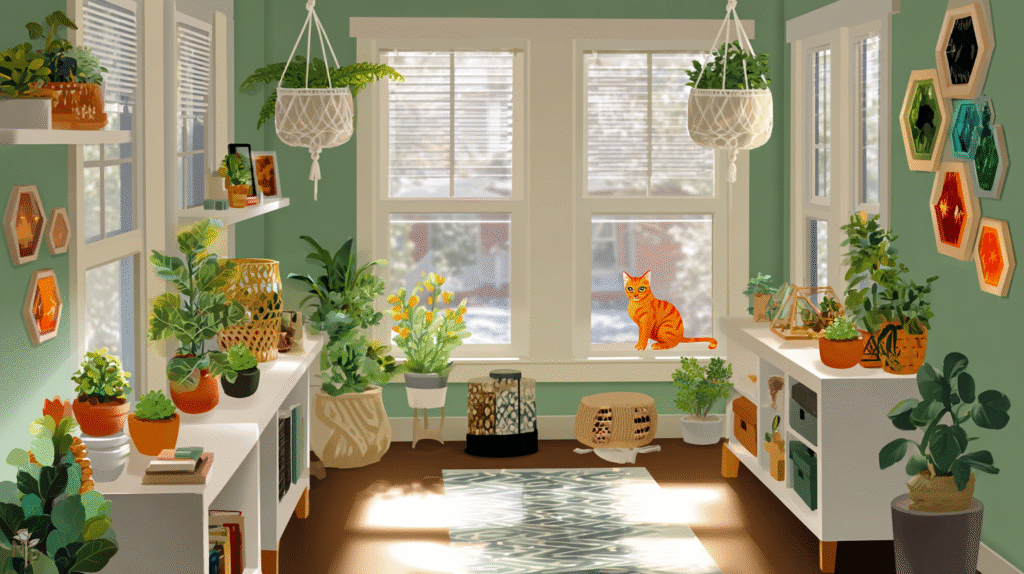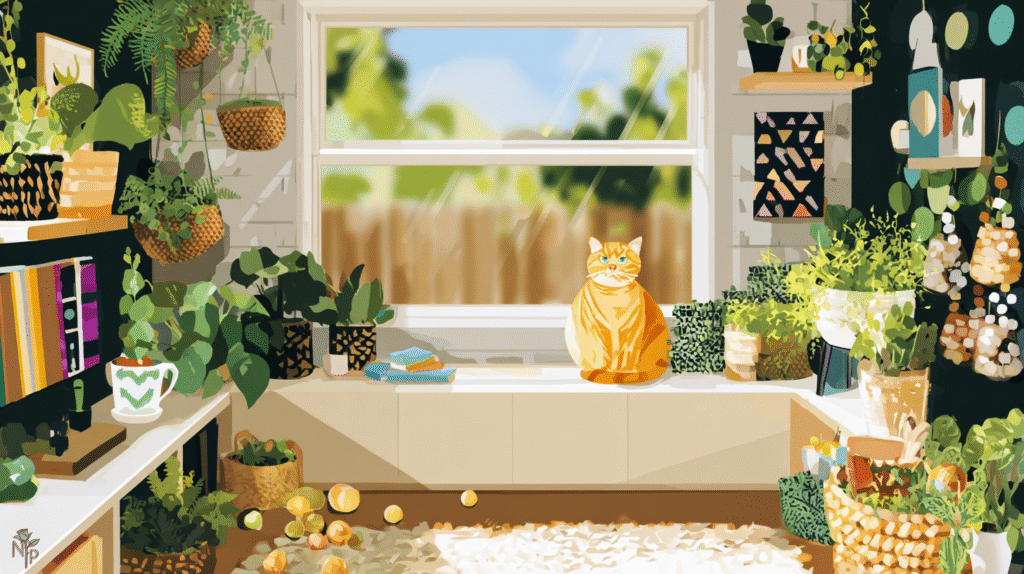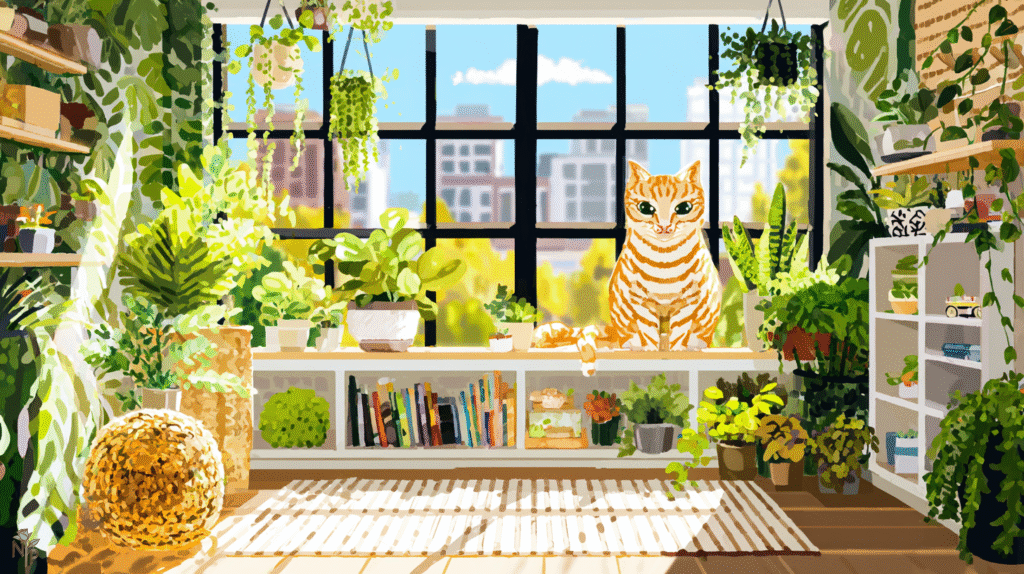The emergency vet looked at me with that face — you know, the “another plant poisoning” face. My orange tabby, Chester, had spent the morning sampling my new peace lily like it was an all-you-can-eat salad bar. Three hundred dollars and one very unhappy cat later, I realized my plant collection was basically a feline death trap.
That was three years ago. Today, my apartment looks like a jungle AND Chester is alive and thriving. Turns out, you can have both cats and plants without turning your home into a danger zone. You just need to know which plants won’t send you racing to the emergency vet at 2 AM.
Here’s everything I learned about identifying truly cat-safe plants — not the “probably okay” lists that nearly cost me Chester’s life.
The Truth About “Non-Toxic” Plant Lists
First lesson: “non-toxic” doesn’t mean “cat won’t get sick.” I learned this when Chester ate half my spider plant (listed as safe everywhere) and proceeded to act like he was high for six hours. Turns out, spider plants are hallucinogenic to cats. Non-toxic? Yes. Problem-free? Absolutely not.
What “non-toxic” actually means:
- Won’t cause organ failure
- Won’t kill your cat
- Might still cause vomiting
- Might still cause diarrhea
- Might make your cat act weird
Now I look for plants that are both non-toxic AND unlikely to cause any reaction. Big difference.
My Verified Cat-Safe Plants (Chester-Tested)
After the peace lily incident, I researched obsessively and tested carefully. These plants have survived Chester’s investigations with zero vet visits:
Boston Fern Chester occasionally nibbles the fronds with no issues. Bonus: the constant frond-dropping gives him something to bat around. Just prepare for mess — these ferns shed more than my cat.
Ponytail Palm (Beaucarnea recurvata) Not actually a palm, totally safe. Chester loves chewing the grass-like leaves. I’ve accepted this plant is partly his personal salad bar. No adverse effects in two years.
Prayer Plant (Maranta leuconeura) Beautiful, moves throughout the day (cat entertainment!), and Chester can nibble without consequence. Though he rarely does — apparently not tasty enough.
Peperomia (All varieties) My collection of eight different peperomias remains untouched. Chester investigated once, decided they’re boring. Perfect.
Cast Iron Plant (Aspidistra elatior) Lives up to its name — indestructible and cat-safe. Chester can’t even damage it when he decides to nap on top of it.
Money Tree (Pachira aquatica) Chester loves rubbing against the braided trunk. Occasionally tastes a leaf, zero problems. Plus, maybe it’ll bring financial luck to cover future vet bills.
The “Safe” Plants That Aren’t Worth the Risk
Some plants are technically non-toxic but caused enough drama that I rehomed them:
Spider Plant: The kitty hallucinogen. Chester acted drunk, knocked things over, generally was a menace. Not dangerous, but not worth the chaos.
Bamboo: Safe but Chester was OBSESSED with chewing it. The constant gnawing sounds drove me insane. Plant survived, my sanity didn’t.
Cat Grass: Obviously safe but Chester would gorge himself then vomit everywhere. Now he gets small amounts only.
Roses: Thorns. Chester vs. thorns = bloody paws and vet visit. Technically non-toxic, practically problematic.

How to Research Plant Safety (Beyond Basic Lists)
After almost poisoning Chester, I developed a paranoid but effective research system:
Step 1: Check ASPCA database Most comprehensive list. Search exact scientific names — common names vary and confuse.
Step 2: Cross-reference with Pet Poison Helpline Sometimes they have different info. If there’s disagreement, I skip the plant.
Step 3: Search “[plant name] cat reddit” Real people’s experiences. Found out about spider plant highs this way.
Step 4: Look for vet clinic warnings Many clinics post about common plant poisonings they see. Real-world data.
Step 5: When in doubt, skip it No plant is worth risking Chester’s life. Learned this the $300 way.
The Surprise Toxins Hiding in “Pet-Friendly” Homes
These common plants nearly fooled me:
Snake Plant (Sansevieria): Everywhere, marketed as indestructible, definitely toxic. Causes nausea and vomiting.
Pothos: The “easy” plant that’s actually toxic. Even the water it sits in can poison cats.
Aloe Vera: But it’s medicinal! For humans. For cats, it causes vomiting and lethargy.
English Ivy: Looks harmless, causes serious stomach upset and drooling.
Rubber Plant (Ficus elastica): That glossy Instagram favorite? Toxic sap causes oral irritation and drooling.
I had ALL of these before Chester’s peace lily incident. The great plant purge of 2021 was painful but necessary.
Creating Safe Spaces for Plants and Cats
Even with cat-safe plants, Chester’s plant interactions needed management:
Hanging solutions: Macramé hangers keep trailing plants away from curious paws. My Boston ferns live in hanging baskets now.
Height advantages: Wall-mounted shelves for plants Chester finds too interesting. He’s lazy enough that climbing isn’t worth it.
Decoy plants: I grow cat grass and catnip to redirect his plant-chewing desires. Works 70% of the time.
Deterrent methods that failed:
- Citrus peels (he didn’t care)
- Aluminum foil (played with it)
- Spray bottles (now he attacks plants when I’m gone)
- Bitter apple spray (licked it off)
The Plant-Identification Apps That Could Save Your Cat
Technology became my best friend:
PlantNet: Free, fairly accurate. I photograph every plant before buying.
PictureThis: Paid app but more accurate. Worth it for peace of mind.
Google Lens: Quick and free, good for common plants.
Pro tip: Screenshot toxic plant images on your phone. Reference while plant shopping. I have a folder called “Plant Death List” with 50+ photos.

Signs Your Cat Ate Something Bad
Chester taught me these warning signs:
Immediate reactions:
- Drooling excessively
- Pawing at mouth
- Vomiting (more than normal hairball)
- Refusing food
Delayed reactions:
- Lethargy
- Hiding behavior
- Diarrhea
- Unusual vocalization
That peace lily incident? Chester drooled like a faucet within 20 minutes. Now I know: any drooling = immediate vet visit.
My Current Plant Collection Setup
Three years post-peace lily disaster, here’s what works:
Living room: Large ponytail palm (Chester’s salad bar), hanging Boston ferns, wall-mounted peperomia collection
Bedroom: Cast iron plant in corner (Chester’s occasional nap spot), prayer plant on dresser
Bathroom: More Boston ferns thriving in humidity, Chester rarely enters
Kitchen: Herb garden on high shelf (basil, oregano, thyme — all safe but out of reach)
Office: Money tree by desk, spider plant hung very high (I like it despite the high risk)
The Unexpected Benefits
Creating a cat-safe plant collection brought surprises:
Discovered new favorites: Would never have tried prayer plants without safety research. Now obsessed with their movement.
Lower maintenance: Many cat-safe plants are actually easier than the toxic ones I used to grow.
Conversation starters: “All my plants are cat-safe” leads to great discussions and plant swaps with fellow cat parents.
Chester’s enrichment: He enjoys the pet grass, watches prayer plants move, and naps under the ponytail palm. Plants became cat entertainment.

Your Cat-Safe Plant Shopping Checklist
- Research before shopping (not in store)
- Know scientific names (common names lie)
- When uncertain, don’t buy
- Ask about recent pesticide use
- Consider your cat’s personality
- Start with one, see how it goes
- Have vet number handy for first few days
The Bottom Line
That $300 peace lily lesson taught me plants are replaceable — Chester isn’t. Now every plant purchase goes through extensive vetting. My collection is smaller but safer. Chester can explore without me hovering anxiously.
Are there gorgeous plants I can’t have? Absolutely. Do I sometimes stare longingly at toxic plants in stores? Definitely. But coming home to Chester safely napping under his ponytail palm beats any Instagram-worthy toxic plant.
The secret to having both cats and plants isn’t complicated: choose plants that won’t hurt your cat, accept some limitations, and remember that your cat’s safety trumps your aesthetic dreams. Trust me — the vet bills from getting this wrong aren’t worth it. 🐱🌿






